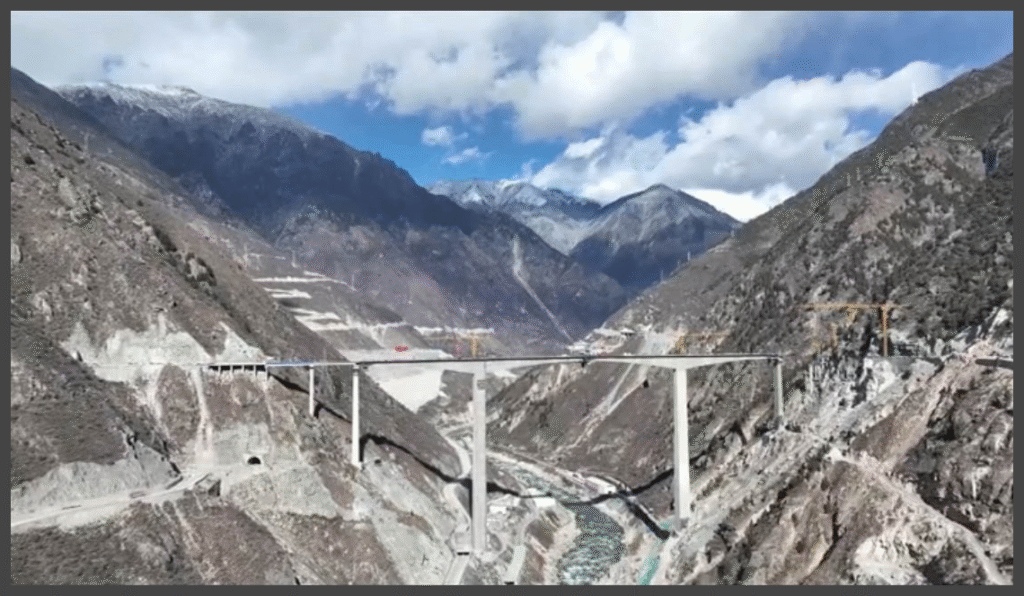
On 11 November 2025, the Hongqi Bridge in Sichuan Province partially collapsed. The 700-metre bridge drew worldwide attention on social media. However, many posts incorrectly use images of an unrelated bridge, the Huajiang Grand Canyon Bridge, creating confusion about which structure actually failed.
Social Media Posts
Posts on multiple social media platforms show a photograph of the Huajiang Grand Canyon Bridge with claims that it collapsed in China, describing it as breaking news.


Fact Check
A reverse image search revealed that the green bridge images supposedly showing the bridge before it collapsed are not of the same structure. Instead, they show an unrelated bridge located in Guizhou, China.
Details of Huajiang Grand Canyon Bridge (Image Used in Error)
The Huajiang Grand Canyon Bridge in Guizhou province spans the Beipan River gorge and opened to traffic on 28 September 2025. According to official sources, it has a deck height of 625 metres and a total length of 2,890 metres, with a 1,420 metre main span.

Source: NBC News
The bridge was built to reduce travel time across the canyon from approximately 2 hours to approximately 2 minutes and to support regional tourism development.
No verified reports of structural failure, collapse, or major incident at the Huajiang Bridge have been found. The bridge appears to remain in service. (Source)
Source: New China TV
What Actually Happened: Hongqi Bridge, Sichuan
On 11 November 2025, local authorities in the city of Maerkang in Ngawa Tibetan and Qiang Autonomous Prefecture, Sichuan province, announced that a section of the Hongqi Bridge had partially collapsed. The 758-metre long structure, part of China National Highway 317 and connecting interior Sichuan toward Tibet, had been completed around 14 January 2025 and officially opened to traffic in April 2025.

Source: Highestbridges.com
On 10 November 2025, authorities closed the bridge after detecting slope deformation and cracks in the roadway and embankment. The following day, worsening instability in the terrain triggered a landslide that caused the approach ramp and roadbed to collapse into the mountainside. No casualties were reported. (Source: Reuters, CNA)
Footage released shows slabs of bridge deck and concrete falling, with large plumes of dust and debris. The bridge opened earlier in 2025 and collapsed within months.
Source: ABC News
Infrastructure Risk and Mountainous Terrain in China
China’s mountainous interior regions, particularly provinces such as Sichuan and Guizhou, present significant geotechnical and terrain-related challenges compared to flat coastal zones. The Hongqi Bridge area is located in a seismically active and landslide-prone region, characterized by steep slopes and mountain rivers. The highway where the Hongqi Bridge was situated connects to Tibet through difficult terrain.
China has undertaken extensive bridge-building projects in such terrain in recent decades. While many projects have been completed successfully, the combination of construction timelines, remote logistics, and complex geology presents certain challenges. The Hongqi collapse highlights how slope movement or geotechnical factors may contribute to structural failure. The incident provides an example of infrastructure development in challenging terrain and high-hazard environments. (Source)
Conclusion
The images circulating on social media falsely depict the Huajiang Grand Canyon Bridge in Guizhou as the collapsed structure. In reality, the bridge that partially collapsed on 11 November 2025 was the Hongqi Bridge in Sichuan Province, a completely different structure located in a landslide-prone area. The Huajiang Grand Canyon Bridge remains intact and operational.

Title:Misleading Images Used in Bridge Collapse in China Claims
Fact Check By: Cielito WangResult: Misleading






